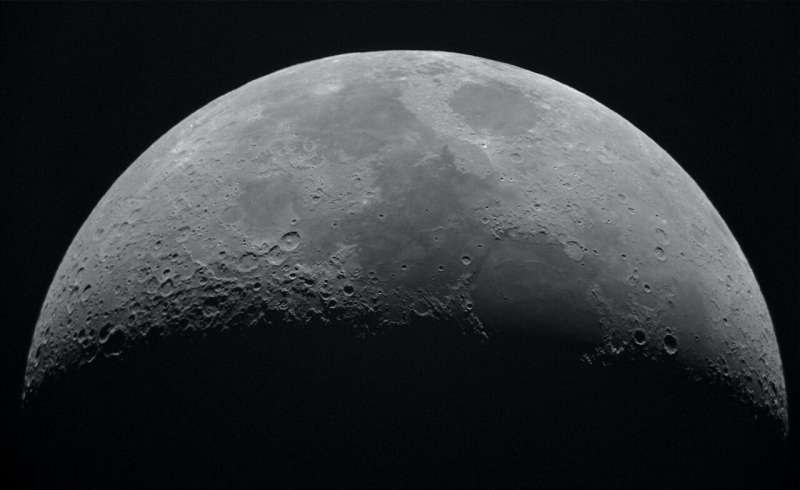
Credit: Unsplash/CC0 Public Domain
Although the moon does not have any breathable air, it has an almost non-existent atmosphere. Since the 1980s, astronomers have observed a very thin layer of atoms impinging on the surface of the moon. This fragile atmosphere—technically known as the “exosphere”—may be the result of a certain weather condition in space. But exactly what those processes might be has been difficult to define with certainty.
Now, scientists from MIT and the University of Chicago say they have identified the main process that created the moon’s atmosphere and continues to maintain it today. In a study published in Advances in Sciencethe team reports that the moon’s atmosphere is a product of “impact steam.”
In their study, the researchers analyzed lunar soil samples collected by astronauts during NASA’s Apollo missions.
Their analysis suggests that during the moon’s history of 4.5 billion years its surface has been repeatedly attacked, first by large meteorites, and more recently, by ” “micrometeoroids” are tiny particles the size of dust.
These constant impacts have lifted the lunar soil, vaporizing certain atoms as they collide and lifting particles into the atmosphere. Some atoms are thrown into the atmosphere, while others remain suspended on the surface of the moon, creating a constant negative atmosphere as the meteorites continue to hit the surface.
Researchers have found that the vapor effect is the main mechanism by which the moon formed and maintained its thin atmosphere for billions of years.
“We provide a definitive answer that meteorite impact vaporization is the primary process that causes the moon’s atmosphere,” said the study’s lead author, Nicole Nie, an assistant professor in MIT’s Department of Earth, Atmospheric and Planetary Sciences. Sciences.
“The moon is about 4.5 billion years old, and throughout that time the surface has been bombarded by meteorites. We show that eventually, the thin atmosphere reaches a stable state because it is still continue to be revived by small effects throughout the month.”
Nie’s co-authors are Nicolas Dauphas, Zhe Zhang, and Timo Hopp at the University of Chicago, and Menelaos Sarantos at the NASA Goddard Space Flight Center.
Weather activities
In 2013, NASA sent an orbiter around the moon to conduct a detailed survey of the atmosphere. The Lunar Atmosphere and Dust Environment Explorer (LADEE, pronounced “laddie”) was tasked with gathering information about the moon’s thin atmosphere, surface conditions, and any environmental influences on lunar dust. .
The LADEE mission was designed to determine the origin of the moon’s atmosphere. Scientists hoped that the probe’s remote measurements of the ground and atmosphere might be consistent with certain atmospheric weather patterns that could explain how the moon’s atmosphere formed.
Researchers suspect that two local weather processes play a role in shaping the moon’s atmosphere: intense evaporation and ion sputtering—a phenomenon that affects the solar wind, transporting energetic particles from the sun across space. When these particles hit the surface of the moon, they can transfer their energy to atoms in the soil and cause those atoms to stabilize and fly into the atmosphere.
“Based on the LADEE data, it appears that both processes play a role,” Nie says.
For example, it showed that during meteorite showers, you see more atoms in the atmosphere, which means that the impacts have an effect. atoms in the atmosphere, which means that the sun also has some influence.
Answers in the soil
To pinpoint the origins of the moon’s atmosphere, Nie looked at samples of lunar soil collected by astronauts throughout NASA’s Apollo missions. He and his colleagues at the University of Chicago obtained 10 samples of lunar soil, each containing about 100 milligrams—a small amount. which he estimated would be equal to one drop of rain.
Nie wanted to start by separating two elements from each sample: potassium and rubidium. Both of these components are “reducible,” meaning they are easily vaporized by impacts and ion sputtering.
Everything exists in the form of several isotopes. An isotope is a variation of the same element that has the same number of protons but a slightly different number of neutrons. For example, potassium can be one of three isotopes, each with one neutron, and heavier than the last. Similarly, there are two isotopes of rubidium.
The team reasoned that if the moon’s atmosphere is made of atoms that have vaporized and suspended in the air, the lighter isotopes of those atoms should be lifted higher, while the heavier isotopes would I stayed in the ground.
Furthermore, scientists predict that the impact vapor, and ion sputtering, should result in very different isotopic compositions in the soil. The specific ratio of light to heavy isotopes left in the soil, for potassium and rubidium, should reveal the primary processes contributing to the origin of the moon’s atmosphere.
With everything in mind, Nie analyzed the Apollo samples by first crushing the soil into a fine powder, then dissolving the powders with acids to purify and separate solutions containing potassium and rubidium. He then ran these solutions through a mass spectrometer to measure the different isotopes of potassium and rubidium in each sample.
The team found that the soil contains very heavy isotopes of potassium and rubidium. The researchers were able to measure the ratio of the heavy to light isotopes of potassium and rubidium, and by comparing the two elements, they found that the impact explosion was the main mechanism by which atoms are lifted and lifted to form the moon’s atmosphere.
“With a strong wind, more atoms would remain in the moon’s atmosphere, while with an ion burst, more atoms would be ejected into space,” says Nie.
“From our study, we can now measure the contribution of both processes, meaning that the relative contribution of vapor effect versus ion sputtering can be 70:30 or more.” In other words, 70% or more of the moon’s atmosphere is the product of meteorites, while the remaining 30% is the result of the solar wind.
“The discovery of such a subtle effect is remarkable, thanks to the innovative concept of combining potassium and rubidium isotope measurements with careful, quantitative modeling,” says Justin Hu, a postdoc studying lunar soils at the University of Cambridge. , who was not involved in the reading room.
“This proposal goes beyond understanding the history of the moon, since such processes can occur and may be more important than other moons and asteroids, which are the goal of many return missions planned.”
“Without these Apollo samples, we wouldn’t have been able to get the right data and mass measurements to fully understand things,” says Nie. “It is important that we bring back samples from the moon and other groups of planets, so that we can paint clearer pictures of the structure of the solar system and its evolution.”
Additional information:
Nicole Nie, Earth’s Month of Atmospheric Losses Record Over Eons, Advances in Science (2024). DOI: 10.1126/sciadv.adm7074. www.science.org/doi/10.1126/sciadv.adm7074
Provided by the Massachusetts Institute of Technology
This story is republished with permission from MIT News (web.mit.edu/newsoffice/), a popular site covering news about MIT research, innovation and education.
Excerpt: Scientists explain pin moon tenuous origin (2024, August 2) Retrieved August 2, 2024 from https://phys.org/news/2024-08-scientists-pin-moon-tenuous -atmosphere.html
This document is subject to copyright. Except for any legitimate activity for the purpose of private study or research, no part may be reproduced without written permission. Content is provided for informational purposes only.
#Scientists #explain #origin #moons #turbulent #atmosphere



